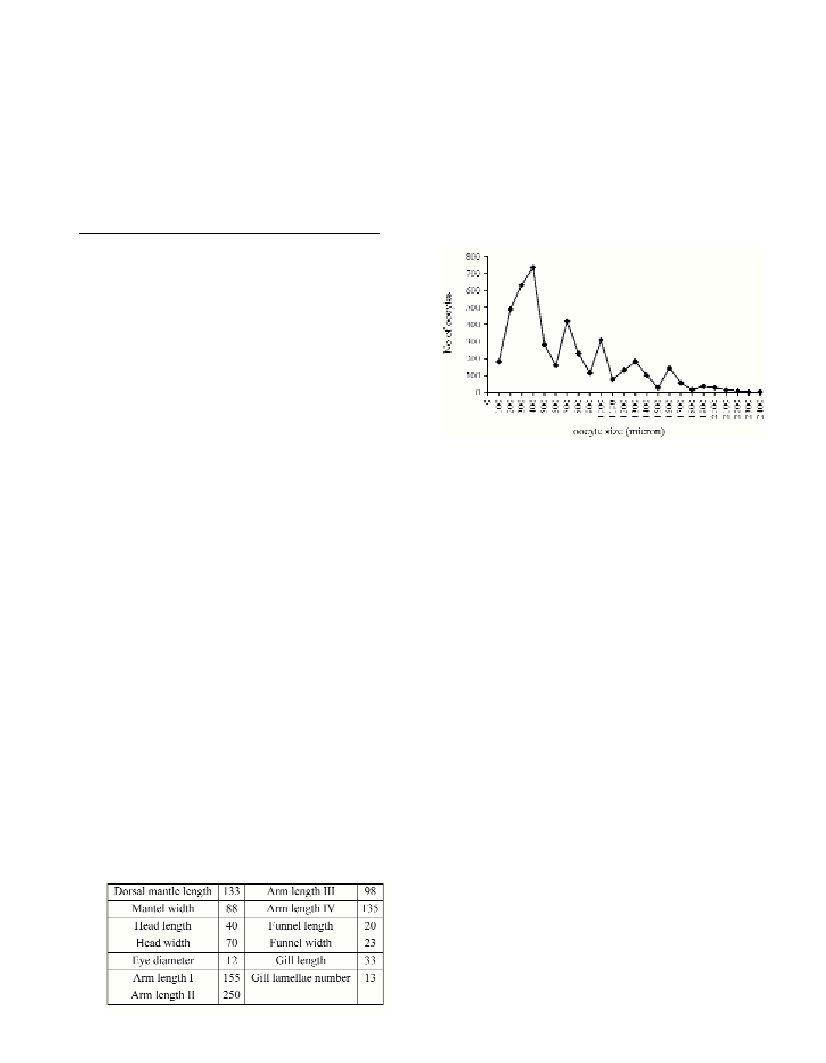OCCURRENCE OF TREMOCTOPUS VIOLACEUSDELLE CHIAJE, 1830
(CEPHALOPODA–TREMOCTOPODIDAE) IN THE STRAIT OF SICILY (MEDITERRANEAN)
D. Massi*, G.B. Giusto and C. Badalucco
MaLiRA-Group - Istituto di Ricerche sulle Risorse Marine e l’Ambiente, sez. di IAMC-CNR,
Mazara del Vallo, Italy - * giusto@irma.pa.cnr.it
Abstract
The occurrence of blanket octopus Tremoctopus violaceusDelle Chiaje, 1830 is reported for the first time in the Strait of Sicily. The
specimen was collected by trawling on January 2003, about 50 nm southward Lampedusa Island on 265 m depth bottoms. The individual
was a maturing female of 133 mm dorsal mantle length and 342 g total weight. Ovary appeared whitish, weighed 4.30 g, with up to six
clusters of oocytes whose size ranged between 0.1 and 2.4 mm.
Keywords: Tremoctopus violaceus, fecundity, Strait of Sicily
Rapp. Comm. int. Mer Médit., 37,2004
398
Introduction
Tremoctopus violaceusDelle Chiaje, 1830 is an epipelagic octopus
distributed in Atlantic Ocean, Caribbean and Mediterranean seas
[1,2,3]. Although the species was considered as “rare”, its presence is
well documented along the Italian coasts. In the last decades, stranded
individuals were reported in the Strait of Messina [4]. A particularly
abundant catch was reported by purse-seine in the Northern
Tyrrhenian Sea, along the coast of Piombino (Leghorn) [5]. The same
authors reported the occurrence of other individuals in the waters
around the Tuscan island of Giglio and Sardinian coast, off Olbia. The
species presence in Italian waters is indirectly documented from a
study of swordfish stomach contents caught in the Southern Adriatic
Sea [6]. Recently, a live, mature female, brooding egg masses at the
base of the first arms, was photographed in the superficial water off
the island of Ponza (Central Tyrrhenian Sea) [7]. The species has not
been previously reported from the Strait of Sicily [8], though an
interesting study about reproductive aspects of T. violaceuswas
recently conducted in Aegean Sea [9].
Material and methods
The specimen was collected by the trawler M/P Salvatore Caterina
of Mazara del Vallo ?eet, trawling a deep water pink shrimp fishing
ground (265 m depth), at about 34°45’00 N and 12°57’00 E. The
specimen was preserved in formol 4% and the main morphological
features were measured [10]. The sex was determined, the
reproductive system removed, and the ovary weighed (0.01 g) to
estimate the potential fecundity (the oocyte number in the ovary). In
particular, three oocyte samples of 0.050 g were taken from three
different parts of the gonad (upper, central and lower) in order to have
a better representation of the whole ovary. Then, in each ovarial
sample, all the oocytes were measured by stereo-microscope under
16x magnification (longest diameter,
µ
) and counted to provide the
oocyte size distribution.
Results
The external morphology and the colour pattern of this individual
agree with the description of literature [2] and the main morphological
data are reported in Table 1. The individual, weighting 342 g, was a
maturing female without ripe eggs in the oviduct. The ovary weighted
4.30g,representing the1.3% of the body weight. The estimated
number of oocytes was 125,500 with a predominant group of tiny
oocytes (No = 66,500, 53% of the total oocyte stock) ranging between
0.1 and 0.6 mm (modal size: 0.4 mm). Five consecutive clusters of
maturing oocytes were present. Their numbers were estimated as
23,150 (modal size: 0.7 mm), 12,150 (1.0 mm), 14,000 (1.3 mm)
6,500 (1.6 mm) and 3,200 (1.9 mm) (Fig. 1).
Discussion
The estimated potential fecundity of the specimen collected falls
within the range of values reported in literature [9] (100,000-300,000
eggs depending on female size). The longest egg size resulted very
close to that found in the eastern Mediterranean [9] (2.4 mm in the
Strait of Sicily, 2.2 mm in Aegean sea) and larger than those reported
for the western basin [11] (up to 1.5 mm).
Previous reports documented maturing specimens in May-August,
but the present female was caught in January. Furthermore, the
presence of several batches of maturing oocytes agreed with the
reproductive pattern of the species, classified as “intermittent and
terminal spawning” [12].
Acknowledgements. Many thanks to the captain of trawler
Salvatore Caterina, Ingargiola Francesco, who kindly gave us the
specimen and the site data.
References
1-Thomas R.F., 1977. Systematics, distribution and biology of
Cephalopods of the genus Tremoctopus(Octopoda: Tremoctopodidae).
Bull. Mar. Sci., 27 (3): 353-392.
2-Nesis K., 1987. Cephalopods of the world. Neptune City, TFH
Publications, 351 p.
3-Mangold K.M., Vecchione M., and Young R., 1996. Tremoctopodidae.
In: Tree of Life. Web Project. www.tolweb.org/tree.
4-Berdar A., and Cavallaro G., 1975. Ulteriore contributo alla
conoscenza dei Cefalopodi spiaggiati lungo la costa siciliana dello Stretto
di Messina. Mem. Biol. Mar. Oceanogr., 5 (5): 121-138.
5-Biagi V., and Bertozzi A., 1992. Presenza stagionale di Tremoctopus
violaceusDelle Chiaje, 1830 (Cephalopoda-Octopoda) nel mare di
Piombino (Li). Boll. Malacol., 28 (1-4): 47-54.
6-Bello G.B., 1993. Tremoctopus violaceus(Cephalopoda:
Tremoctopodidae) in the stomach content of a swordfish from the Adriatic
Sea. Boll. Malacol.,29 (1-4): 45-48.
7-Belluscio A., Ardizzone G.D., Conticelli M., and Pellicciari C., 2003.
Prima documentazione fotografica di Tremoctopus violaceus(Octopoda,
Tremoctopodidae) nel Mediterraneo. Presented at XXXIV Congresso
S.I.B.M., Sousse 1-7 giugno 2003.
8-Jereb P., and Ragonese S., 1994. The Mediterranean Teuthofauna:
towards a biogeographical coverage by regional census. II: Strait of Sicily.
Boll. Malacol., 30 (5-9): 161-172.
9-Laptikhovsky V., and Salman A., 2003. On reproductive strategies of
the epipelagic octopods of the superfamily Argonautidea (Cephalopoda:
Octopoda). Marine Biology, 142: 321-326.
10-Roper C.F.E., and Voss G.L., 1963. Guidelines for taxonomic
descriptions of cephalopod species. Mem. Nat. Mus. Victoria, 44: 49-63.
11-Naef A., 1928. Die Cephalopoden, Embryologie. Fauna Flora Golf
Neapel, 35: 357 p.
12-Rocha F., Guerra A., and Gonzales A.F., 2001. A review of
reproductive strategies in Cephalopods. Biol. Rev., 76: 291-304.
Fig. 1.Tremoctopus violaceus-Oocytes size distribution.
Table 1. Main morphological features of the female of Tremoctopus vio-
laceuscaught in the Strait of Sicily (lengths in mm).

